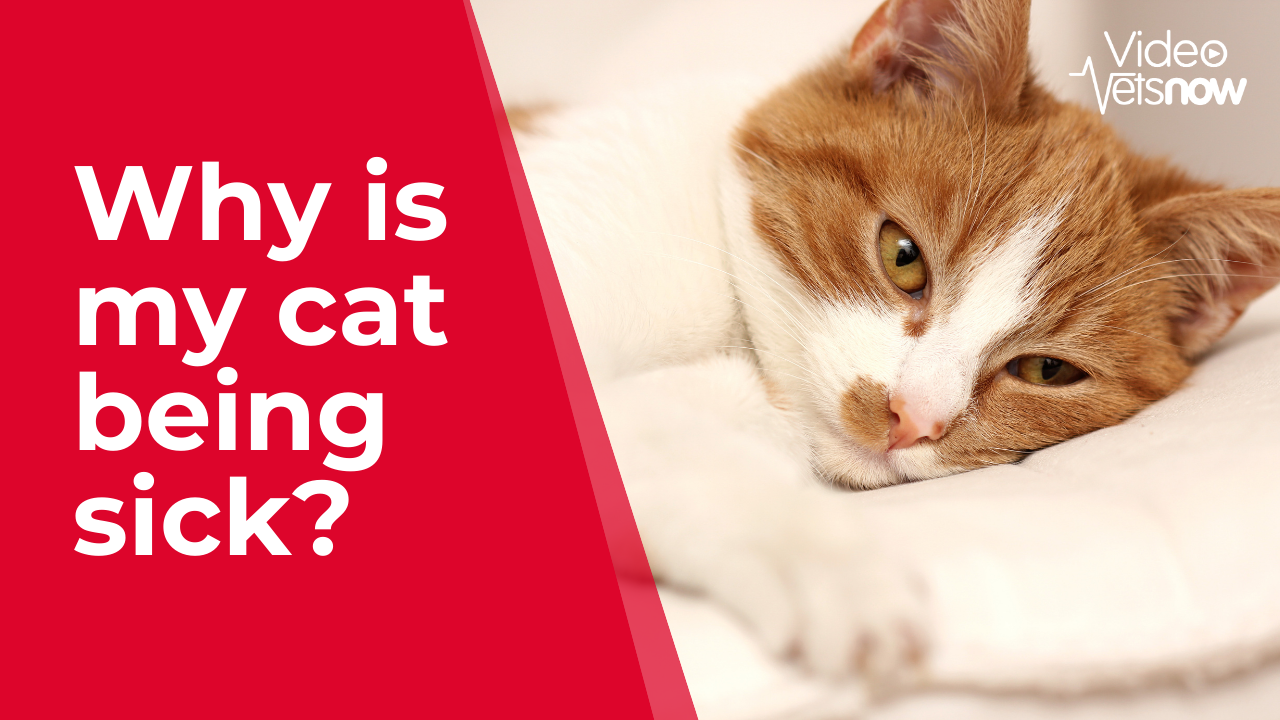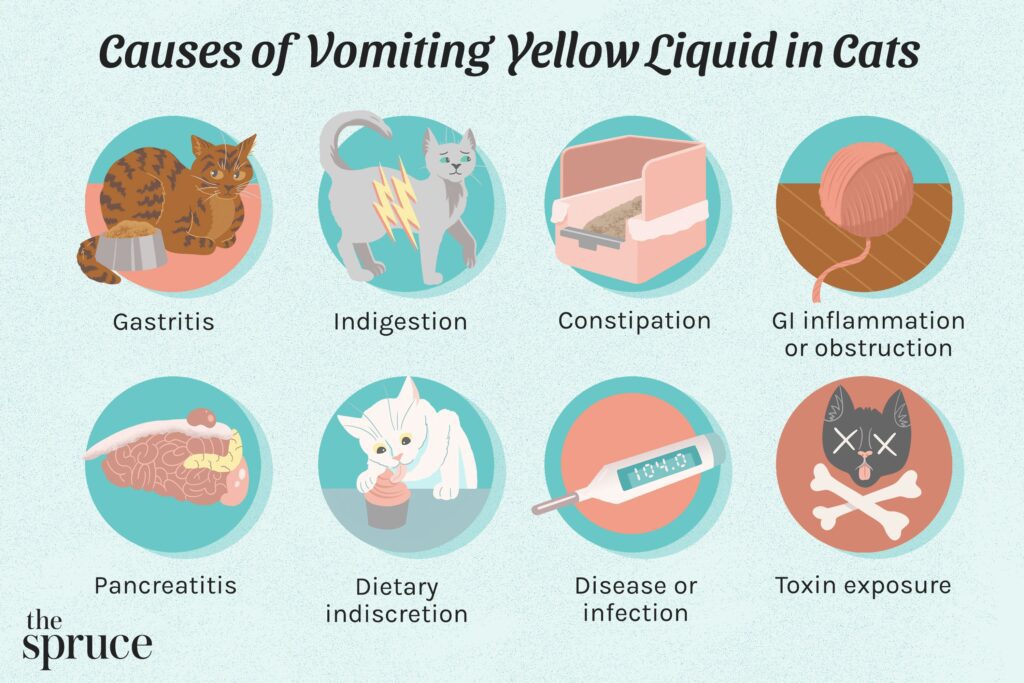Cat Throwing Up Brown Liquid means vomiting brown liquid can be a sign of various conditions, like gastrointestinal issues. Immediate veterinary attention is recommended to assess the cause.
Cats may vomit for numerous reasons, ranging from dietary indiscretion to more serious health concerns. When a cat throws up a brown liquid, this could indicate anything from having eaten something disagreeable to experiencing a blockage in its gastrointestinal tract.
It’s critical for pet owners to monitor their cats closely for additional symptoms such as lethargy, diarrhea, or loss of appetite, which could suggest an underlying illness. Quick action and consultation with a vet can help ensure the health and well-being of your feline friend. Establishing the reason behind the vomiting is essential in providing the appropriate treatment and care for your pet.
:strip_icc()/Cat-eats-and-throws-up-5070200-f9262a790b9d44f1885d018e5ed56b75.jpg)
Credit: www.thesprucepets.com
Feline Upset: The Vomiting Dilemma
Cat parents often face the alarming sight of their feline friend vomiting. When this vomiting presents as a mysterious brown liquid, worry often sets in. Understanding what could cause such an unsettling incident is vital for every pet owner’s peace of mind and the wellbeing of their furry companion.
Patterns and Frequencies of Vomiting
Patterns And Frequencies Of Vomiting
Noticing how often a cat vomits is crucial. Keeping track can reveal if this is an emergency. A one-off incident could simply be a passing issue. Regular vomiting, on the other hand, signals a problem.
- Single Event – May not be alarming.
- Daily Episodes – Require immediate attention.
- Weekly Occurrences – Suggest chronic conditions.
Deciphering the Color: Why Brown Matters
Deciphering The Color: Why Brown Matters
The color of vomit gives clues about health issues. Brown can point to several possible causes:
| Color Shade | Possible Causes |
|---|---|
| Dark Brown | Digested food, internal bleeding |
| Light Brown | Irritated stomach, bile issues |
Always consult a vet if brown vomit occurs. Quick response ensures the best care for a cat’s health.
The Inner Workings Of A Cat’s Digestive System
Is your furry friend unexpectedly ill? Let’s explore the inner workings of a cat’s digestive system to understand why your cat might be throwing up brown liquid. A cat’s digestive health is critical. Cat owners must be vigilant about any changes in their cat’s vomiting patterns.
Anatomy Of Feline Digestion
The digestive system of a cat is a complex route that processes food into energy and nutrients. Digestion begins in the mouth where teeth and enzymes break down food. This mashed food then travels down the esophagus into a cat’s stomach. Here, strong acids and digestive juices continue the breakdown process.
- Mouth: Teeth chop food; enzymes initiate digestion.
- Esophagus: Carries food to the stomach.
- Stomach: Acids and enzymes degrade food.
- Small Intestine: Nutrients absorption occurs here.
- Large Intestine: Extracts water and prepares waste.
The small intestine is the next stop where nutrients get absorbed. The residue reaches the large intestine to absorb water and forms waste. Any interruption in this process could cause a cat to vomit.
Common Digestive Interruptions
A cat vomiting brown liquid could suggest something is wrong within their digestive system. The brown color often indicates digested blood or food, pointing to issues like:
| Condition | Indicator |
|---|---|
| Gastrointestinal Inflammation | Brown Vomit |
| Internal Bleeding | Dark, Coffee-Ground Like Vomit |
| Blockage | Repeated Vomiting |
| Digestive Infections | Diarrhea, Fever |
It’s essential to consider other factors like the cat’s diet, recent activities, and overall health. Vomiting can occur due to hairballs, dietary indiscretion, or more severe conditions such as kidney failure or liver diseases. Immediate veterinary care is crucial if vomiting persists.
Decoding Brown Vomit: What The Hue Indicates
Cats sometimes vomit brown liquid, confusing their owners. It’s crucial to understand the color clues to take prompt action. This section breaks down what brown vomit might mean for your feline friend, from minor digestive upsets to more serious health conditions.
Blood Presence In Vomit
Brown vomit can indicate blood in your cat’s digestive tract. The blood mixes with vomit, giving it a brown color. Reasons could vary from simple irritation to internal injuries.
- Dark brown with a coffee-ground look could mean old blood.
- Reddish or fresh-looking specs point to newer bleeding.
Brown Vomit As A Symptom Of Underlying Issues
A cat’s brown vomit is often a sign of underlying problems. Cause identification is key for proper treatment. Common issues include:
| Condition | Symptoms |
|---|---|
| Foreign Bodies | Lethargy, loss of appetite |
| Infections | Fever, diarrhea |
| Gastrointestinal Problems | Bloating, abdominal pain |
Other signs accompanying brown vomiting such as behavior changes, appetite loss, or lethargy need immediate vet attention.
Dietary Causes Behind Brown Liquid Vomit
Dietary Causes Behind Brown Liquid Vomit
When your cat throws up brown liquid, it’s natural to feel concerned. Before you panic, understanding dietary causes is crucial. This unpleasant symptom could stem from something as simple as the foods they eat. To ensure your feline friend’s health, let’s explore dietary triggers.
Food Intolerances In Cats
Just like humans, cats can have food intolerances. These can cause digestive upset and vomiting. Identifying the problem food is your first step. Common intolerant foods include:
- Dairy products – Many felines lack the enzyme to digest lactose.
- Beef, fish, or chicken – Some cats struggle with certain proteins.
- Artificial additives – Coloring and preservatives can upset a cat’s stomach.
If you suspect intolerances, consult with a vet. They may advise an elimination diet to pinpoint the cause.
The Impact Of Diet Changes On Feline Health
Switching your cat’s diet abruptly can result in vomiting brown liquid. Their digestive systems need time to adjust. Tips for a smoother transition include:
- Introduce new food gradually. Mix it with the old food over a week or more.
- Choose high-quality cat food. Look for natural ingredients and proper nutrition.
- Keep fresh water available. Hydration is key during any diet change.
Observe your cat’s reaction to new diets and seek veterinary guidance if vomiting persists. Proper care ensures a happy, healthy pet.
Illnesses Related To Brown Vomit In Cats
Seeing your cat throw up is worrying. Brown vomit can be a sign that your cat is ill. It is key to understand which sicknesses could cause this symptom. Quick action might save your cat’s life. Now, let’s explore the potential illnesses tied to brown vomit in cats.
Digestive System Diseases
Cats’ brown vomit often points to a digestive issue. Here are common diseases:
- Gastritis: This is an inflamed stomach. It makes a cat feel sick.
- Intestinal Blockage: Things a cat eats can block its guts. This is dangerous.
- Inflammatory Bowel Disease: Cats’ guts get swollen and don’t work right.
- Liver Disease: A bad liver can make vomit turn brown.
Systemic Illnesses And Brown Vomit
Besides gut issues, whole-body sicknesses might cause brown vomit:
- Dehydration: Not enough water impacts cats’ health a lot.
- Kidney Failure: Bad kidneys make waste build up in blood. Cats sometimes puke because of this.
- Pancreatitis: A swollen pancreas can hurt a cat badly. It can cause brown throwing up.
- Metabolic Disorders: Problems in a cat’s body systems could lead to brown vomit.
Each sickness needs a vet to check it out. They will say what treatment your cat needs. Acting fast helps your furry friend stay healthy.
Toxins And Poisons: External Factors Causing Vomiting
When your cat throws up brown liquid, it’s alarming. It could be a sign that your furry friend has encountered toxins or poisons. Such substances often lurk unnoticed in many homes. You must know these hazards to protect your pet. Here’s a look at the common household toxins that can affect cats and signs that may indicate your cat has been poisoned.
Household Toxins Affecting Cats
Cats are curious by nature. They explore and sometimes ingest harmful substances. Several household items can cause vomiting. We’ve listed some below:
- Cleaning supplies: Bleach, detergents, and other cleaners can poison cats.
- Plants: Lilies, poinsettias, and tulips are toxic to felines.
- Human food: Onions, garlic, and chocolate are dangerous for cats.
- Medications: Human medicines like Ibuprofen can lead to severe poisoning.
Signs Of Poisoning In Felines
Knowing the signs of poisoning can save your cat’s life. Look for these symptoms:
| Symptoms | Action |
|---|---|
| Vomiting | Consult a vet immediately |
| Diarrhea | Keep them hydrated |
| Difficulty breathing | Provide fresh air and call the vet |
| Lethargy | Don’t wait; see a vet |
If you see these signs, act fast. Contact your vet or an emergency pet hospital. Protect your cat by keeping hazardous items out of reach.
Home Care Tips For Vomiting Cats
Seeing your cat throw up brown liquid can be alarming. Understanding that vomit could be a sign of digestive issues, it’s crucial to know how to care for your feline at home. Here are thoughtful, vet-approved measures to ensure your beloved pet recovers safely and comfortably in the familiar surroundings of your home.
Setting Up A Recovery Space At Home
Your cat needs a quiet, warm, and comfy spot to recover. Select a low-traffic area away from noise and commotion. Ensure the space is easily cleanable in case of more vomiting. Place their favorite bed or blanket here. Keep water nearby, but you may need to limit food initially depending on your vet’s advice.
- Clean, soft bedding to make them comfortable.
- Water bowl filled with fresh water, but observe drinking habits.
- Access to a quiet and dimly-lit environment for stress-free recovery.
Dietary Adjustments During Recovery
What your cat eats is vital during this delicate time. Start with a 24-hour fast to rest their stomach, only if recommended by your vet. Post-fast, introduce a gentle, bland diet. Think boiled chicken or white fish with no seasonings. Portion meals into smaller, frequent servings. This gives their digestive system a chance to cope.
| Days After Vomiting | Diet Type | Portion Size | Frequency |
|---|---|---|---|
| Day 1 | Boiled chicken | Small | Every few hours |
| Day 2 | Bland, soft food | Moderate | Three times a day |
| Day 3+ | Gradual reintroduction to regular diet | Normal | Regular feeding schedule |
Always consult with your veterinarian before making any dietary changes. They can guide you on the appropriate food and portions for your specific cat’s condition. Not all cats are the same; what works for one may not suit another. Monitoring is key — keep an eye on their recovery and watch for signs of improvement or if they need to see the vet.
Over-the-counter Aids And When To Use Them
Discovering your cat spewing a brown liquid can be alarming. Sometimes, quick action with over-the-counter aids can help. But knowing when and which products are safe is crucial. Below, explore safe nausea medications for your feline and understand the risks associated with self-medicating.
Safe Medications For Nausea
Mild nausea doesn’t always need a vet visit. Over-the-counter options may help. Bismuth subsalicylate, known as Pepto-Bismol, is one example. However, it’s essential to get the correct dose for your cat’s size. A simple rule: never give medicine meant for humans unless your vet says it’s okay.
- Famotidine (Pepcid): Reduces stomach acid and can help if vomiting is due to gastric irritation.
- Meclizine (Dramamine): Useful for motion sickness, it may curb vomiting in cats with similar symptoms.
Risks Of Self-medicating Without Vet Consultation
Cats are sensitive creatures. The wrong medicine or dose can cause harm. Liver damage, kidney failure, or worse could occur. Symptoms like brown vomit can indicate severe health issues. That’s why it’s key to talk to a vet before giving any medication.
| Medicine | Possible Risk |
|---|---|
| NSAIDs (e.g., Ibuprofen) | Highly toxic, can lead to ulcers and kidney damage |
| Acetaminophen (Tylenol) | Fatal, damages red blood cells and causes liver failure |
Your vet’s advice is essential. Self-medicating could mask symptoms of a serious condition. Always seek professional guidance before administering any over-the-counter aids.
Probiotics And Supplements For Vomiting Relief
If your cat is throwing up brown liquid, it’s clear something isn’t right with their digestion. Thankfully, probiotics and supplements might help. These can restore balance to your furry friend’s tummy, reducing the distress and mess that comes with vomiting.
Role Of Probiotics In Digestive Health
- Probiotics are good bacteria that aid digestion.
- They fight harmful microbes and maintain gut health.
- Giving cats probiotics can reduce discomfort and prevent vomiting.
Introducing probiotics to your cat’s diet can make a big difference. These friendly bacteria work to keep their insides running smoothly.
Supplements To Support The Feline’s System
| Supplement | Benefits | Dosage |
|---|---|---|
| B-complex vitamins | Boost metabolism, enhance energy | Varies per product |
| Omega-3 fatty acids | Promote healthy coat, aid digestion | According to weight |
| Digestive enzymes | Assist in breaking down food | Follow vet’s advice |
Supplements can also support your cat’s health. They can help fill any dietary gaps and boost their overall well-being. It’s essential to pick the right product and proper dosage for the best effect, often with a vet’s guidance.

Credit: www.wagr.ai
Importance Of Hydration And How To Maintain It
Cats need to stay hydrated, especially after throwing up. Vomiting can lead to a loss of fluids and essential minerals. This can harm kitty health. It’s crucial to ensure they drink enough water. Proper hydration helps their body recover faster and prevents further issues. Let’s look at ways to monitor and maintain your cat’s hydration levels.
Monitoring Water Intake After Vomiting
After your cat vomits, watch how much water they drink. Offer fresh water and make sure the bowl is clean. Try using running water from a fountain to encourage them. This can be more inviting for cats. Track how often they drink. If your cat doesn’t drink by itself, seek vet advice.
- Check the water bowl regularly.
- Use a fountain to stimulate drinking.
- If not drinking, consult a vet.
Electrolyte Solutions For Dehydration
If your cat is dehydrated, electrolyte solutions can help. These solutions replenish lost minerals. Always ask a vet before giving your cat any solution. Never give human electrolyte solutions to cats.
| Signs of dehydration: | What to do: |
|---|---|
| Lethargy | Offer electrolyte solution |
| Dry gums | Consult your vet |
| Less pee than usual | Check water intake |
Recognizing The Need For Veterinary Intervention
Is your cat vomiting brown liquid? This can be scary.
Some cats may get an upset stomach from time to time. But when should you worry? Let’s talk about signs that suggest a trip to the vet is a must.
Red Flags In Vomiting Cats
Not all vomiting is an emergency. But look out for these concerns:
- Frequent vomiting: More than once can be bad.
- Brown liquid: This color can mean internal issues.
- Weakness or lethargy: If your cat is tired and vomiting, it’s serious.
- Refusal to eat or drink: A hungry, thirsty yet sick cat is worrying.
- Blood: Vomit with red means a vet visit right away.
- Painful belly: If touching causes pain, that’s a concern.
The Role Of Diagnostic Tests In Identifying Causes
Vets can run tests to find out why your cat is sick. These are some common ones:
| Type of Test | What it Helps Discover |
|---|---|
| Bloodwork | Checks for signs of infections, kidney or liver problems. |
| Ultrasound | Finds issues in organs like the stomach or intestines. |
| X-rays | Can show blockages or abnormal masses. |
| Endoscopy | Allows a close look inside the stomach. |
Remember, early help from a vet can make a big difference. If your cat’s symptoms match any red flags, please seek veterinary care.

Credit: www.vets-now.com
Veterinary Treatments For Brown Vomit
Cats throwing up brown liquid can be distressing. Brown vomit may suggest a blockage or stomach issue. Seek veterinary care promptly. Early diagnosis and treatment can be lifesaving.
Medications Prescribed By Vets
When cats vomit a brown liquid, veterinarians often prescribe medication to help. Here are some common medicines:
- Anti-nausea Drugs: These help control vomiting and ease the stomach.
- Antibiotics: If an infection is causing the vomiting, antibiotics are necessary.
- Parasite Control: To eliminate worms or other parasites that might cause symptoms.
- Probiotics: To restore the gut’s healthy balance.
Always give medicines as directed. Never use over-the-counter drugs without a vet’s advice.
Invasive Vs. Non-invasive Procedures
Different procedures help diagnose and treat the reason for the vomit.
| Non-Invasive Procedures | Invasive Procedures |
|---|---|
| Ultrasound | Exploratory Surgery |
| Endoscopy | Foreign Body Removal |
| Blood Tests | Biopsy |
Non-invasive tests often come first. They are easier on your pet. If these fail to find the problem, surgery or biopsies might be necessary.
Always follow the vet’s guidance on the best course of action.
Prevention Strategies To Reduce Future Episodes
Seeing your cat vomit brown liquid can be worrisome. It may signal something more than a simple upset stomach. To help your feline friend, prevent these scary episodes before they start. A focus on diet and lifestyle goes a long way. Let’s explore steps to keep your cat healthy and happy.
Optimizing Your Cat’s Diet
Your cat’s nutrition is key. Sometimes, brown vomit is due to dietary issues. Here are ways to provide a balanced diet:
- Quality Food: Choose high-quality, easily digestible food.
- Proper Portions: Feed your cat the right amount to avoid overeating.
- Regular Schedule: Stick to set feeding times to regulate digestion.
- Hydration: Ensure fresh water is always available.
Consult your vet for a diet tailored to your cat’s needs.
Environmental And Lifestyle Changes
Stress and activity levels affect your cat’s health. Consider these changes:
- Stress-Free Space: Create a calm environment at home.
- Play Time: Encourage regular play to boost health.
- Clean Bowl: Always offer food in a clean dish.
- Quiet Feeding Area: Feed your cat in a peaceful spot.
Another great tip is to keep toxins out of reach. Cats are curious, and certain plants and foods can upset their stomachs. Secure trash cans, and store chemicals safely.
The Role Of Regular Health Check-ups
The Role of Regular Health Check-Ups cannot be overstressed when it involves the well-being of our furry friends. Cats often hide their discomfort, so illness might go unnoticed. A cat throwing up brown liquid signifies a possible health concern. Regular check-ups are vital for early detection and treatment.
Routine Visits To The Veterinarian
Scheduling routine check-ups is a proactive approach to your cat’s health. Regular examinations by a vet can uncover issues that are not obvious. A vet can spot early signs of illness. This is key to preventing severe health issues. Regular visits can save your cat from discomfort and save you from high medical costs later on.
- Weight checks: To monitor for unexpected loss or gain.
- Dental assessments: Helps prevent diseases and maintains oral hygiene.
- Physical examinations: Check overall health and look for subtle signs of illness.
Benefits Of Regular Bloodwork For Cats
Bloodwork is an essential tool in a veterinarian’s arsenal to keep your cat healthy. It offers a detailed look into the health of your cat. This test can uncover problems even before symptoms show up. Catching diseases early often leads to better outcomes. Bloodwork can spot signs of:
| Condition | Indicators in Bloodwork |
|---|---|
| Liver Issues | Elevated liver enzymes, bilirubin |
| Kidney Problems | Abnormal creatinine and BUN levels |
| Infection or Inflammation | Increased white blood cells |
Collecting bloodwork during regular check-ups builds a health baseline. Any deviation from this baseline may point to health issues. Bloodwork also allows for personalized care for your cat based on its unique health profile.
Real Stories Of Recovery: Cat Owner Experiences
Witnessing a beloved cat throw up brown liquid can be alarming for any pet owner. Yet amidst worry, there’s hope in stories from others who’ve walked this path. Let’s explore tales of feline recovery and insights gained along the journey.
Success Stories Of Managing Digestive Issues
Cat owners reveal triumphs over frightening digestive woes. Each narrative embodies strength, understanding, and the power of timely veterinary care. Here are highlights from these healing tales.
- Lola’s Recovery: A diet change and medication restored her health.
- Simba’s Progress: After an infection, regular check-ups kept him on track.
- Bella’s Comeback: Probiotics and love brought her back to wellness.
Lessons Learned From Handling Cat Vomiting
Cat guardians shared valuable nuggets of wisdom picked up from dealing with their pet’s sickness.
| Lesson | Impact on Cat Care |
|---|---|
| Stay Calm | Calmness helps your pet and allows you to think clearly. |
| Act Quickly | Fast action can prevent more severe health issues. |
| Keep Records | Document symptoms and treatments for vet visits. |
With each experience, owners found silver linings. These moments of crisis became stepping stones to a healthier, happier life for their feline friends.
Frequently Asked Questions Of Cat Throwing Up Brown Liquid
Why Is My Cat Throwing Up Thick Brown Liquid?
Your cat may be vomiting thick brown liquid due to digestive issues, ingestion of something inedible, or a potential underlying health condition. Consult a veterinarian for accurate diagnosis and treatment.
What Does Brown Vomit Mean?
Brown vomit may indicate the presence of dried blood, potentially signaling an upper gastrointestinal bleed. It generally requires an immediate medical consultation.
When Should I Be Worried About My Cat Throwing Up?
Seek veterinary attention for your cat if vomiting persists for more than 24 hours, occurs repeatedly, or if your cat displays lethargy, diarrhea, or signs of pain. Also be alert if the vomit contains blood or if your cat shows signs of dehydration.
What Does Unhealthy Cat Throw Up Look Like?
Unhealthy cat vomit may contain blood, be dark brown, or have a strong bile odor. Consistently foamy or contains foreign objects indicates possible health issues. If concerns persist, consult a veterinarian for advice.
Conclusion
Dealing with a cat’s health issues can be distressing, especially when symptoms are as alarming as vomiting brown liquid. It’s essential to monitor your feline friend closely and seek veterinary guidance to determine the underlying cause and proper treatment. Remember, prompt action can safeguard your pet’s well-being and ensure they remain a happy, healthy member of your family.







